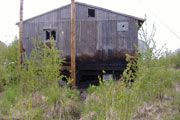Tuluksak Old Power Plant
- View detailed information from the database on this site.
- Database Name: Tuluksak Old Power Plant
- Status: Active
- Location: Tuluksak
- Latitude: 61.096910
- Longitude: -160.947647
-
Key DBAC Services:
- Site Assessment
- DBACs Awarded: 2010
- DEC File Number: 2451.38.002
DEC Contaminated Sites contact: Naomi Mason, Project Manager, 907-269-7527 (Anchorage)
Site Narrative
- Requested by the Tuluksak Native Council

Old power plant in Tuluksak
The Tuluksak old power plant was built in the early 1980s and is owned by the Tuluksak Native Community. Photographs of the site indicate potential petroleum contamination related to an aboveground fuel storage tank and the power plant itself. The Tuluksak Native Community Council and the Association of Village Council Presidents Regional Housing Authority have been building new houses in the new Tuluksak River Subdivision, but further development has been delayed because of the fire hazard and health risks associated with the contamination at the old power plant. The last house was built in 2003 and community members are in need of additional housing.
In 2010, DEC provided site assessment services and a Property Assessment and Cleanup Plan (PACP) was completed for the Tuluksak Old Power Plant site. No sampling was conducted during this field work. Based on the site visit, SLR, DEC’s contractor, determined that in order for the site to be reused, used oil, used glycol, derelict equipment and other solid waste should be removed. Once these items are removed then the extent of contamination should be evaluated. SLR estimates a minimum of 75 cubic yards of contaminated soil will need to be excavated. During the site visit, extensive soil contamination from past releases was noted under the building. Hazardous materials consisting of old mechanical devices and other debris, approximately one hundred 5-gallon buckets containing used oil and glycol, lead-acid batteries, generators, and transformers stored with no secondary containment. In addition, three transformers, twenty-five 55-gallon drums, six old generators, and up to 15 heavy equipment batteries are stored on the ground on the west and southwest areas of the Site.
DEC and the community have communicated since the PACP and discussed next steps. An additional site visit and sampling occurred in August 2019.
